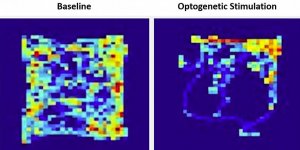| News / Science News |
Structure of receptor involved in brain disorders
NIH | JUNE 10, 2014
Scientists determined the structure of the intact NMDA receptor, an ion channel involved in many brain-related illnesses including Alzheimer’s disease, depression, schizophrenia, and autism. The finding may aid in the development of future therapies.
Nerve cells relay information between each other through specialized connections known as synapses. Synapses contain numerous proteins that help regulate message transmission. One key protein structure is a channel in the nerve cell surface called the NMDA (N-methyl, D-aspartate) receptor. It regulates the flow of ions into the cell, in turn triggering numerous biochemical processes.
Activation of the NMDA receptor is thought to play a role in learning and memory. Too much or too little activation of the NMDA receptor channel has also been linked to several neurological and psychiatric disorders.
The NMDA ion channel receptor is made up of 4 separate subunits, with 2 each of 2 different subunits. The structures of parts of these subunits are known. Drs. Erkan Karakas and Hiro Furukawa at Cold Spring Harbor Laboratory set out to determine the structure of the assembled NMDA receptor ion channel in order to better understand how the receptor functions.
The researchers made NMDA receptors in insect cells and then purified them. They crystallized the receptors in the presence of various chemicals that turn the channel on or off. Using X-ray crystallography, they were able to resolve the structure of the complete protein. By forming crosslinks between the 4 subunits to further stabilize the structure, they resolved it in even greater detail.
They found that the receptor is shaped like a hot air balloon. The basket part corresponds to the transmembrane domain—the part that goes through the cell membrane. This forms a gated channel, allowing ions—such as calcium—to enter the nerve cell. The balloon part of the receptor complex is located outside the cell. This area is where chemicals, known as neurotransmitters, bind to the receptor to turn it on or off.
The scientists further examined how the subunits fit together, and where molecules bind to trigger the channel to open or close. They compared the structure to those of similar types of ion channel receptors to better understand its function and regulation.
YOU MAY ALSO LIKE



